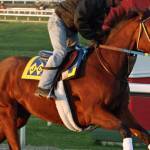What Happens to the Skeleton During Early Training of Racehorses?

Previous studies have found a decrease in the mineral content of the third metacarpal bone during the first months after a young horse leaves a breeding farm environment and enters race training. To explore the skeletal adaptations involved in early race training, bone density and morphometry were tracked in 15 Thoroughbred yearlings as they began training at a facility where turnout paddocks were available.
The horses were stalled for about 6 hours per day and training consisted of 15 to 20 minutes of slow jogging per day. After the first month they were moved to a facility without turnout where the horses were stalled for 23 hours each day. They were lightly exercised for two months and then began training more intensely.
During training, dorsopalmar radiographs of the third metacarpal bone were taken on a monthly basis and an aluminum step wedge was exposed simultaneously as a reference standard. Plasma concentrations of calcium, phosphorus, and osteocalcin were also measured monthly.
Bone mineral content dropped while the horses were confined to stalls with only light exercise. When training intensity increased, bone mineral content also increased. Plasma concentrations of calcium, phosphorus, and osteocalcin followed similar patterns.
This report of KER’s 2007 research was published in Proceedings of the 20th Equine Science Society Symposium.
Read the entire research paper, titled Skeletal Adaptations with Onset of Training in Thoroughbreds.








